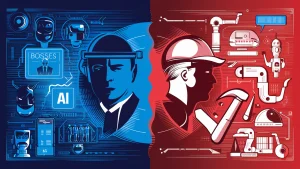ReadWriteWeb

Artificial intelligence software reduces productivity and harms the working environment, according to a study from the freelance platform, Upwork.
The findings appear to question how AI is being deployed at present, with a lack of understanding between staff and management on aims and expectations. The data suggests a long way to go before the advantages of the evolving technology are fully utilized.
The research was carried out on behalf of Upwork by Walr, earlier this year. 2,500 workers from the US, Canada, the UK, and Australia were polled. The respondents consisted of 1,250 C-suite executives, 625 full-time, salaried employees, and 625 freelancers, made up of different demographics between the ages of 18 and 78.
One of the headline findings from the survey points to an immediate disconnect. Management is expecting and encouraging workers to use AI to increase productivity but the demand for more comes at a cost.
“Seventy-one percent are burned out and nearly two-thirds (65 percent) report struggling with increasing employer demands,” according to the survey. “Alarmingly, one in three employees say they will likely quit their jobs in the next six months because they are burned out or overworked.”
Bosses are also asking staff to expand their skill sets (35%), take on a wide range of responsibilities (30%), return to the office (27%), work more efficiently (26%), and work more hours (20%).
Workplace leaders expect generative AI will help boost productivity compared to existing levels (96%), with 39% of companies in the study already deploying AI tools, and encouraging the use of the tech.
Failing to unlock the productivity value of AI
The dividend has not yet arrived, nor has the feeling of benefit with ordinary workers. Around half (47%) of workers already using AI say they don't know how to reach the productivity gains expected. 77% stated AI tools have had the opposite effect, diminishing productivity and adding further to the workload.
An interesting contradiction of sorts is that 65% of employees share expectations on machine learning making them more productive, but the reality stands out from the perception.
40% of workers feel too much is being asked of them with AI. The lack of preparation is heightened with 37% of C-suite leaders at firms using AI rating their workforce as skilled and ready to use the tools. That contrasts with just 17% of workers who agree with the statement.
Almost all (96%) execs see AI driving productivity but just over a quarter (26%) have implemented training courses, and a lowly 13% have reported a "well-implemented AI strategy.
The survey shows the disconnect in the workplace over AI and is reflected by the comments of Kelly Monahan, managing director of The Upwork Research Institute who stated:
“Our research shows that introducing new technologies into outdated work models and systems is failing to unlock the full expected productivity value of AI.”
“While it’s certainly possible for AI to simultaneously boost productivity and improve employee well-being, this outcome will require a fundamental shift in how we organize talent and work.”
Image credit: Via Ideogram
The post Does AI increase productivity at work? New study suggests otherwise appeared first on ReadWrite.

Artificial intelligence is here already, it is tipped to own the future, but a new theory puts forward the case that AI “inbreeding” could lead to self-inflicted demise.
From Google to Microsoft, OpenAI, and many smaller startups at the other end of the scale, LLMs and the AI tools they train have changed technology as we know it. AI is here to stay, it is already making a significant impact on our online world and everything that runs through it.
Further evolution appears inevitable but at what cost, and to what extent? We know already it is extremely expensive to provide the engine room that powers AI, with the server-heavy system just about coping. The advances in AI are remarkable but so is the depth of resources required for the big tech companies to underpin the system.
Irreversible defects in the resulting models
“Model collapse” considers that we might already have witnessed the peak of AI models, presenting the theory that as more and more web content becomes AI-generated, the tech will eventually “inbreed” on existing trained data leading to flaws as human-led data becomes increasingly scarce.
A new paper published in Nature delves further into this concept, which includes the following explanation:
“We find that indiscriminate use of model-generated content in training causes irreversible defects in the resulting models, in which tails of the original content distribution disappear,” states the abstract. “We refer to this effect as ‘model collapse’ and show that it can occur in [Large Language Models] as well as in variational autoencoders (VAEs) and Gaussian mixture models (GMMs).”
Big tech firms are drawn to the bright, shiny advances of AI, and the spike in shares that it propels. That is not the same as underlying profit which eventually will take its toll, and what of the climate cause? AI is power-intensive, requiring data center expansion and further demands on resources.
The dial is unlikely to be shifted anytime soon by the concept of “model collapse” but it is another interesting question that will be answered further down the line.
Image credit: Via Ideogram
The post AI ‘inbreeding’ among chatbots like ChatGPT could lead to its demise appeared first on ReadWrite.

Jersey City Mayor Steven Fulop announced on Thursday that the city’s municipal pension plan will soon invest in Bitcoin (BTC) through exchange-traded funds (ETFs).
Not my normal subject matter in a post but I'll share anyway – the question on whether Crypto/Bitcoin is here to stay is largely over + crypto/Bitcoin won. The #JerseyCity pension fund is in process of updating paperwork to the SEC to allocate % of the fund to Bitcoin ETFs… https://t.co/5iNEqRqHGM
— Steven Fulop (@StevenFulop) July 25, 2024
The move follows a similar investment by a Wisconsin pension fund earlier this year, signaling a growing trend among public retirement systems. Mayor Fulop, who has led Jersey City since 2013 and is now running for New Jersey governor in 2025, shared the news on social media platform X (formerly Twitter). He wrote:
The question on whether crypto/Bitcoin is here to stay is largely over and crypto/Bitcoin won.
Fulop added that the Employees Retirement System of Jersey City is currently updating paperwork with the U.S. Securities and Exchange Commission (SEC) to allocate a portion of its funds to Bitcoin ETFs. The investment is expected to be finalized by the end of summer.
Details still vague
While the exact percentage of assets to be invested wasn’t specified, Fulop indicated it would be “similar” to the 2% allocation made by Wisconsin’s state pension fund earlier this year. The specific Bitcoin ETF for the investment has not been announced.
The mayor expressed his long-standing belief in cryptocurrency and blockchain technology, calling the latter “amongst the most important new technology innovations since the internet.”
This development is part of a broader trend of growing interest in Bitcoin from public pension funds. Wisconsin’s public pension plan, with approximately $156 billion in assets, invested $160 million in spot Bitcoin ETFs earlier this year. Smaller funds, like the Houston Firefighters’ Relief and Retirement Fund, have been invested in crypto for several years.
Back in late March, Japan's Government Pension Investment Fund was reportedly considering Bitcoin as a potential investment diversification tool amidst economic and technological changes. As of December 2023, GPIF managed assets totaling 225 trillion Japanese yen ($1.54 trillion), securing its position as the largest pension fund globally.
The post Jersey City Pension Fund to Invest in Bitcoin ETFs appeared first on ReadWrite.

There is a fairly good chance that you will land a three-of-a-kind in poker at some point. Our guide unpacks this hand, what it is, what beats it, and also reveals some probabilities so you can play confidently. Sounds good? Let’s first examine what this poker hand looks like.
What Does Three Of A Kind Look Like in Poker?

3 of a kind cards are exactly what the name implies: three cards of the same rank plus two unrelated cards. There are 242 possible 3-of-a-kind hands in a 52-card deck.
What are the Odds and Probability of 3 of a Kind in Poker?
In basic terms, odds are the chance of something happening, while probability represents its likelihood. The probability of getting a poker three-of-a-kind hand is 2.11% or 1 in 47.
Where Does a Three Of A Kind Rank in the Poker Hand Ratings Chart?
Good knowledge of poker hand hierarchy helps you know when to hold or fold. The 3-of-a-kind poker hand ranks seventh on the poker hand rankings chart.
What Does a Three-of-a-kind Beat in Poker?
Ranking seventh, the 3-of-a-kind poker hand is lower in the pecking order of poker hands when playing Texas Hold’em and Omaha Poker.
| This hand does not beat a Royal Flush | ❌ |
| This hand does not beat a Straight Flush | ❌ |
| This hand does not beat Four Of A Kind | ❌ |
| This hand does not beat a Full House | ❌ |
| This hand does not beat a Flush | ❌ |
| This hand does not beat a Straight | ❌ |
| This hand beats Two Pairs | ✔️ |
| This hand beats One Pair | ✔️ |
| This hand beats a High Card | ✔️ |
Does Three Of A Kind Beat A Royal Flush in Poker?

Of course not. A royal flush is the unbeatable hand, with odds of 649,739 to 1. Compare this with 47 to 1 for three-of-a-kind in poker.
Does 3 Of A Kind Beat a Straight Flush?

Again, no. A three-of-a-kind cannot beat a straight flush in poker. Just consider the odds. You can expect to get a straight flush once in 72,193 hands.
Does Three Of A Kind Beat Four Of A Kind?

No, Four of a Kind is a much stronger poker hand. Just look at the 3 of a kind examples and odds and probabilities, and you will see why. As mentioned earlier, the odds of getting three of a-kind in a 52-card deck are 1 in 47 hands, compared to 1 in 4,164 for four of a kind.
Does 3 Of A Kind Beat a Full House?

Not a chance. Three-of-a-kind poker hands cannot beat a full house, which is made up of 3 of a kind and a pair. With odds of one in 695 hands, a full house is a higher-ranking poker hand.
Does a Three Of A Kind Beat a Flush?

No. Three-of-a-kind does not beat a flush in poker. Again, considering 3-of-a-kind probability, it’s easy to see that at 1in 509 hands, a flush is rarer than three-of-a-kind.
Does a 3 Of A Kind Beat a Straight?

What beats three-of-a-kind in poker? A straight with odds of 1 in 254 hands. While 3 of a kind is a good hand, it cannot beat a straight in poker.
What Other Hands Do Three Of A Kind Poker Hands Beat?
You have learned what is a three-of-a-kind in poker and what beats it. Let’s now look at what falls to this hand. Here, we refer to two pairs, one pair, and the high card.
- Two Pairs – A poker hand with two different pairs and a fifth unrelated card
- One Pair – This hand has one pair and three unrelated cards
- High Card – This just represents the highest ranking card according to poker ranking rules. It’s useful when no one at the table has any of the hands listed in this guide or you are playing a bluff.
Who Wins if Both Players Have a 3 Of A Kind?
In this situation, the player with the highest-ranking three related cards wins. Let’s consider an example where one player has AAA84 and another KKKQJ. Aces trump kings, so the first hand wins.
What is the Difference Between a Set vs Trips?
Trips and sets are both 3 of a kind examples but differ in how the hands are constructed. A set is a pocket pair plus one same-ranking community card, while trips can be constructed with one card from your hand and two same-rank community cards.
- Set – Get K, K, and then combine with another K from the community cards
- Trips – You have J, K in your hand, and then get J, J, and 4 from the community cards
What Are The Odds Of Hitting Trips With Any Pocket Pair?
The odds of hitting trips in poker with any pocket pair is 0%. Trips can only be constructed when you are not starting with a pocket pair.
However, you can hit a set on the flop when you start with a pocket pair, and the odds of that scenario playing out are 11.8%
| 3 Of A Kind Probability | Pocket Aces | Pocket Aces, Kings, Queens, or Jacks | Any other pocket pair |
|---|---|---|---|
| Pre Flop Odds | 0% | 0% | 0% |
| Post Flop Odds | 11.8% | 11.8% | 11.8% |
| After The Turn Odds | 15.64% | 15.64% | 15.64% |
| After The River Odds | 19.31% | 19.31% | 19.31% |
What is the Best Site to Learn Poker Hands?
CoinPoker is an excellent choice for new players learning poker. It includes various guides and learning material on poker topics, such as card ranking and playing strategies. These guides make learning easy because they are prepared by experts with beginners in mind.
Sign up To Claim 150% Deposit Bonus Up To $2,000
- The main CSOP tournament series guarantees $1,000,000 in prize money
- Low and high-stakes tables are always available, 33% Rakeback
- No KYC process, decentralized blockchain poker
Conclusion
This guide is a fantastic starting point for new players learning about this hand in poker and the intricacies of the 3 of a kind poker hand. We have covered what the three-of-a-kind hand is and how to identify them. We have also looked at the different hands that beat 3-of-a-kind and their probabilities.
In addition, you will now have learned information like:
- What is 3 of a kind in poker? – 3 of a kind is a hand that has three cards of the same rank plus two unrelated cards
- Probability of 3 of a kind – The probability of getting a poker 3-of-a-kind hand is 2.11%, or 1 in 47, so now you understand the odds.
- What is stronger between 3 of a kind and a pair – You now know that this hand is the seventh strongest poker hand and will always beat a pair
- Odds of hitting trips on flop – You now understand the difference between trips and a set which are both three-of-a-kind poker hands
- What beats 3 of a kind in poker? – Royal flush, straight flush, four-of-a-kind, full house, flush, and a straight will beat a 3-of-a-kind in a showdown as you have now learned from this guide
But this is just the beginning. We have guides covering more advanced poker topics below.
Related Poker Guides
- Poker Bankroll Management
- Poker Strategy
- How To Win At Poker
- Types of Poker Games
- Poker Terminology
- Best Poker Streamers
- Poker Positions
Three-of-a-Kind FAQs
Does 3 Of A Kind beat three pairs in poker?
What are the odds of hitting trips on the flop?
What are some 3-of-a-kind examples?
How should you play a Three-of-a-kind poker hand in Omaha poker tournaments?
What is the best site for learning how to play poker?
Responsible Gambling
One of the best ways to protect yourself when playing online is to educate yourself about responsible gambling. Several resources are available, but we have listed some of the most popular ones here to help you get started.
National Council on Problem Gambling
Responsible Gambling Council
American Gaming Association Responsible Gambling
References
Content suitable for 18+ readers only. Always gamble responsibly. The content found in this article is not to be taken as betting advice. Speculative gambling could lead to a loss of capital. It’s free to use this website, but we might receive a commission from companies featured within it. If you are having trouble with gambling then help and advice can be found at begambleaware.org
The post What is Three Of A Kind in Poker and How Does This Hand Rank? appeared first on ReadWrite.

Leading US cryptocurrency exchange Coinbase has appointed three new members to its board of directors, expanding the board from seven to ten members.
According to Reuters, the new board members include former OpenAI executive and former president Bill Clinton aide Chris Lehaneç former United States Solicitor General under President George W. Bush Paul Clement. Lastly, the board now also hosts Christa Davies, the Chief Financial Officer at Aon.
This move strengthens Coinbase’s bipartisan credentials at a time when the crypto industry is gaining political significance. Republican presidential nominee Donald Trump has already received millions in crypto donations, primarily in Bitcoin (BTC).
The roles
Lehane, who will serve as strategic counsel to Coinbase, recently emphasized the importance of bipartisanship in crypto’s success. He revealed that he had been in discussions with Coinbase’s leadership team for years, offering advice on building trust and maintaining a bipartisan approach. He said:
I think it's one of the unique aspects of this space: You can be an economic freedom person, maybe more libertarian or you can be me, an economic opportunity person. And you can see within digital assets how it can support a different type of financial system.
Clement is expected to advise Coinbase on regulatory matters, particularly in addressing what the company sees as overreach by the Securities and Exchange Commission (SEC). Davies will focus on enhancing Coinbase’s financial and operational excellence globally.
Paul Grewal, Coinbase’s Chief Legal Officer, praised Lehane as “one of the foremost political and legal strategists of our time,” highlighting his expertise in crypto’s growing political importance.
The expansion of Coinbase’s board comes at a crucial time for the cryptocurrency industry, as it seeks clearer regulations and broader acceptance in the financial and political spheres. These high-profile appointments reflect Coinbase’s strategy to navigate the complex regulatory landscape and strengthen its position in the evolving crypto market.
The new additions come as the company positions itself to capitalize on potential regulatory improvements following the upcoming November elections. Trump has long positioned himself as a crypto-friendly candidate, but now Democrat candidate Kamala Harris is similarly
The post Coinbase expands board with former OpenAI exec, clinton aide appeared first on ReadWrite.
